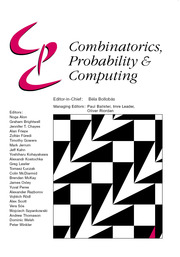No CrossRef data available.
Article contents
A stability theorem for multi-partite graphs
Published online by Cambridge University Press: 11 August 2025
Abstract
The Erdős–Simonovits stability theorem is one of the most widely used theorems in extremal graph theory. We obtain an Erdős–Simonovits type stability theorem in multi-partite graphs. Different from the Erdős–Simonovits stability theorem, our stability theorem in multi-partite graphs says that if the number of edges of an  $H$-free graph
$H$-free graph  $G$ is close to the extremal graphs for
$G$ is close to the extremal graphs for  $H$, then
$H$, then  $G$ has a well-defined structure but may be far away from the extremal graphs for
$G$ has a well-defined structure but may be far away from the extremal graphs for  $H$. As applications, we strengthen a theorem of Bollobás, Erdős, and Straus and solve a conjecture in a stronger form posed by Han and Zhao concerning the maximum number of edges in multi-partite graphs which does not contain vertex-disjoint copies of a clique.
$H$. As applications, we strengthen a theorem of Bollobás, Erdős, and Straus and solve a conjecture in a stronger form posed by Han and Zhao concerning the maximum number of edges in multi-partite graphs which does not contain vertex-disjoint copies of a clique.
MSC classification
Information
- Type
- Paper
- Information
- Copyright
- © The Author(s), 2025. Published by Cambridge University Press


